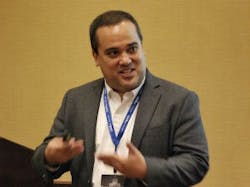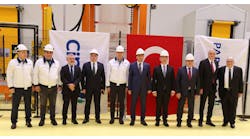“It can interact with existing architectures, with no need to rip and replace.” Schneider Electric’s Helenio Gilabert described applications of edge technology in the oil & gas industry at this week’s Innovation Days.
We need look no further than the Internet to see that technology is changing at an ever-faster pace, with innovation everywhere. Sitting, waiting and watching the change is not really an option. “Disrupt or be disrupted,” said Helenio Gilabert, senior director, edge solutions, Schneider Electric. “The cost of innovation is much lower. Any one of us can go and sign up for Amazon Web Services (AWS), get unlimited storage and processing power, move data from A to B—an explosion of capabilities.”
Gilabert spoke at Schneider Electric Innovation Days, this week in Austin, Texas.
“What can add value to your business?” Gilabert asked. In the past, we had time to contemplate, understand and select. “Today, we need to find where to get the returns we need to remain profitable. Business models have started to change—not just what we’re doing, but how we’re doing things. We need to change our organizations, cultures and processes.”
Industry lags commercial applications and today, we’re still at an early stage of adoption. “But, how many of us still support their own email? Their own file sharing? These are cloud-based, and that’s becoming the norm. OT is lagging a little behind, but a lot of things are becoming cloud-enabled,” Gilabert said. “See what’s happening in IT. The same will happen in OT.”
Among the drivers is digitalization, where a proliferation of sensor data is demanding more storage and OT infrastructure. “Then, there’s the generational shift,” Gilabert said. “Young people expect to be fully mobile, to run their life and business from their mobile phone, anywhere, anytime.” Finally, there are big data and analytics. “These things are not new, but now they’re cheaper, faster and accessible to all,” Gilabert said.
Edge computing evolution
Processing power doubles, and its cost halves every 18 months. More can be achieved in a very cost-effective manner by bringing consumer technology into the industrial space. “We’re using Linux on standard machines with built-in I/O, Node Red and Docker. We didn’t develop the platforms, we use what’s out there,” Gilabert said. “The value is in the software—a clear separation as opposed to an industrial controller, where the programing is specific to the hardware environment.”
Gilabert acknowledged that today, this hardware is not suitable for some applications, such as safety, high redundancy, or Class I, Div. 2 environments. “I think they’ll evolve to support those applications in the future, because volume makes them cheap,” he said.
The value of the edge becomes clear when you bring alternatives together “in a seamless way,” Gilabert said. “The cloud has issues—security, jurisdiction—but if you can extend it to the edge, you have a choice.” An application can run in the cloud or at the edge, depending on business requirements. For example, “You can run the process at the edge, and its digital twin in the cloud, and failover non-critical processes from the edge to the cloud,” Gilabert explained. “We can tap the potential of artificial intelligence (AI) and machine learning, which was difficult to do when it had to run in the server room. We can deploy it at the equipment, for instance, a pump, to do specific apps for specific assets. We can train and adapt it to the characteristics of an individual piece of equipment to increase its effectiveness.”
When to use the edge
How do you decide if the edge is the correct place for a computational task? Gilabert said there are five key aspects to help you decide:
- What’s the acceptable latency? “For predictive maintenance, five minutes is no big deal, you can run it in the cloud. But for operations, for example, an oil-producing pump where production drops due to sand in the pump, you need to know right now,” Gilabert said. “Make a decision as fast and as close as possible, and automatically if you can.”
- What’s the role of the Internet? “At the edge, you’re not dependent on the connection to the Internet,” Gilabert said. “You can cut the connection, and send data once a day to the cloud, where it can be used to improve models and performance across the fleet. You can choose to do that or not. And if the connection is lost, that’s OK.”
- What security is required? “Cloud connections may give no control over channels to vendors, which is a risk,” Gilabert said. “With the edge, you can send what you choose, for example, only the results, not the data, on interfaces you manage and control.”
- Is cost a priority? The edge is cost-effective. “It can interact with existing architectures, with no need to rip and replace,” Gilabert said. You can run it in parallel with existing systems, bring on new programs and abilities, then slowly migrate as capabilities evolve. “Greenfields can use it directly, but with legacy systems, this can happen over many years,” he said. Let critical process control stay where it is, with redundancy, etc., and add secondary improvements, such as monitoring pump vibration and currents. He said, “It’s easier, cheaper and faster to deploy on the edge.”
- Do you need interoperability? “With PCs in the field and Linux, it’s easy to develop drivers,” Gilabert said. “We work with a company dedicated to that. You can easily add a gateway and connect to the controllers, ours and others.”
Make the business case
In one example, a company has pumps in the field, hundreds of feet underground, with onsite controllers and memory cards. Traditionally, cards were collected from the controllers, returned to a central location, read and reviewed. “Instead, bring the data in and use machine learning to identify issues,” Gilabert said. With this approach, the company is now analyzing production issues as well as mechanical issues.
But, AI needs experts to teach it, with asset-centric machine-learning models at the edge, to unlock the value. The end objective is the autonomous operator, with operators transferring their knowledge to machine learning systems.
“You can optimize a pump far beyond what could be done before,” Gilabert said. Operators can influence, control and improve accuracy. They can see inferred values, for example, a virtual flowmeter based on temperature and pressure readings, not just temperature and pressure. Safety and emissions people can see spills and alarms. “And, this is just the beginning,” he said.
“It’s not just a technical revolution. It also changes your relationships with your vendors,” Gilabert said. “Before, you owned it all. Now, you can pay for what you use, a subscriber model. Why own automation? Own your own business equipment, buy automation as a service and let the vendor optimize it. The models are continuing to grow, allowing you to focus on your own business.”
Business is changing, and you need to change how you do business. “Never start with the technology, start with the business problem,” Gilabert said. When a team that wanted to automate the wells went to management, management said no, it’s too expensive. They went back and added up the drive time of all the operators, which came to $7 million per year. When they showed that to management and said they could cut it in half, it was approved.
“Start small, prove value and scale up fast,” Gilabert said. Select the right problems and business cases, then pay attention to people. “The number one reason projects fail is not doing change management for the people and culture,” he said. “You need to change not just the technology, but the way you do work.”





